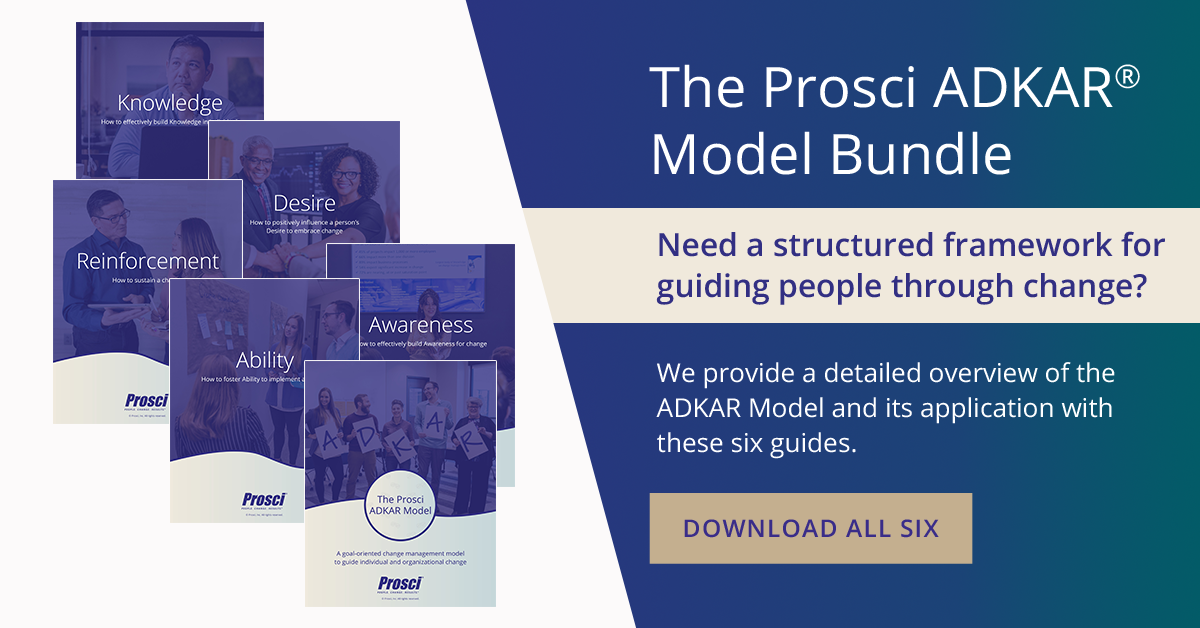Individual Barriers to Change and What to Do About Them

6 Mins
Updated: August 30, 2022
Published: August 7, 2019

The Prosci ADKAR Model is a framework for managing and understanding individual change. The model consists of five building blocks that must be achieved for change to be successful: Awareness of the need for change, Desire to participate and engage in the change, Knowledge of the skills and competencies needed to successfully change, the Ability to perform the necessary skills, and the Reinforcement to sustain the change. Progressing from one element of the model to the next is not constant or a given because individuals usually reach barrier points. Here's what to do about them.
Ready to learn more about the Prosci ADKAR Model and how it helps people navigate change?
Explore and share our free 7-in-1 eBook bundle.
Addressing Individual Barrier Points in the ADKAR Model
Consider each ADKAR element in the example profiles that follow. Each profile shows how far an individual has progressed in achieving the ADKAR elements on a scale of 1 to 5, with 1 being the lowest and 5 being the highest. Typically, scores less than 3 suggest that the individual needs additional work on that element. The "barrier point to change" is defined as the first ADKAR element with a score of 3 or less on this scale. For example, if you were to rate an employee with the scores shown in Profile 1 below, Awareness would be defined as the barrier point to change.
The term "barrier point," as used here, means that you first must address this ADKAR element before moving forward in the model. For example, you would not want to send an employee to a training course to address Knowledge when the employee has no Awareness of the need for change or has no Desire to engage in that change.
Profile 1: Barrier point at Awareness

In our Best Practices in Change Management studies, research participants consistently identify lack of Awareness as the primary reason why employees and managers resist a change. Without Awareness of the need for change, individuals lack crucial pieces of information and block progress with change.
When the barrier point is at Awareness or Desire, you will see little or no evidence that the change is taking place. This is the most obvious and important observation: change is not happening with this person.
If the barrier point is Awareness of the need for change, you may see the person simply ignoring the change completely. They may pretend that no change is going on and simply continue with business as usual. If confronted, the person may question why the change is needed, or argue or debate the reasons for change. It is not uncommon for an employee to defend the current state, especially if they helped create the process or tools currently in use.
Building Awareness is the first step in enabling a successful change. Awareness sets the foundation for helping individuals make personal choices about the change at hand. This first step requires effective communications from the sponsor of the change, as well as careful coaching by the employee's immediate supervisor. Employees need to know the nature of the change, why the change is happening, and how the change aligns with the direction of the organization. They need to hear these messages from people they trust. Some employees may need time to digest this information and internalize the business reasons for the change. Some employees may need to hear the message multiple times from different people.
Profile 2: Barrier point at Desire

As with lack of Awareness, you may first identify lack of Desire by noticing that the change is not taking place with an employee. When a person lacks Desire to change, you will observe the person disengaging from work, either partially or completely. If the change has a large impact on the person's day-to-day activities, you can expect them to become increasingly distracted or absent, or start to seek other work opportunities (this is where employee turnover begins). Some employees may openly resist the change. Others may find passive ways to resist such as garnering support from other employees, or by spreading misinformation or rumors about the change. In the worst case, an employee may attempt to sabotage the change by deliberately taking actions that disrupt or interfere with the change process. If confronted, employees at this stage of the ADKAR Model may show fear or uncertainly around the desired future state or become angry at being "forced" to change. It's not uncommon for such an employee to have low overall morale or a poor outlook.
Desire is often the most difficult element to facilitate in another person. Any manager or sponsor attempting to help another person attain this element will be challenged because the factors causing lack of Desire are not always within the manager's control. For example, lack of Desire may be related to a personal situation outside of work or one's financial status. Therefore, the first step to building Desire is not to act but to listen. An effective change leader will first seek to understand the root cause of an employee's lack of Desire and explore all the facets of the change that may be impacting this individual. Because Desire to participate and engage in a change is ultimately a personal choice, the manager must be willing to address "what's in it for me" or WIIFM from the employee's perspective.
Profile 3: Barrier point at Knowledge

Knowledge is the third element in the ADKAR Model. Knowledge in this context means understanding how to change, having the skills and training on the new tools or processes, and understanding the new roles or responsibilities required to change. Recall that the first observations we made around lack of Awareness or Desire were that the change was not happening with the employee. When someone lacks Knowledge or Ability, the opposite is true. The first observation is that an employee is trying to change. But when an employee lacks Knowledge, you will observe honest attempts at making the change happen, which often don't work out.
These employees will often say they don't know what to do or they lack the necessary skills. You can expect frequent questions and increased demands on managers' and co-workers' time. Typically employees who lack Knowledge about how to change but try anyway are troubled by mistakes and rework, and therefore become frustrated and discouraged. They may even develop low confidence and increasing fear of making more mistakes
If the barrier point at Knowledge is not resolved, the cost of change increases. This uses additional resources, and employees may become so frustrated that they give up. Ways to address the barrier point of Knowledge include training on the change process itself (enabling employees to recognize what's happening and take control of their own situation), training on the new tools and process, and direct coaching from the employees' immediate supervisors or managers.
Profile 4: Barrier point at Ability

Does attaining the Knowledge regarding a change automatically lead to having the Ability to change? No, but it's a common misconception among change practitioners. The element of Ability is when "walking the walk" becomes reality. Whether from a physical disability, mental block, function of time, or lack of resources, it's possible that an individual may have the Awareness of, Desire for and Knowledge to change, but may not be able to perform the change. An example is an individual who takes golf or swimming lessons but may not be a proficient golfer or swimmer. Until the majority of employees successfully attain the Ability element, the change will not begin yielding desired outcomes.
As with Knowledge, the first observation you might make when an employee lacks Ability is the employee trying to change. In this case, you can expect them to take longer to perform the necessary tasks. Productivity will be low. Employees at this barrier point seek constant help from their manager or co-workers. Some of these employees may feel disappointed in their own performance, and they can become upset over the mistakes they make. Left unattended, these employees may attempt to find work-arounds that are easier for them, even if these work-arounds do not align with the change. It's not uncommon for an employee who started with strong levels of Awareness, Desire and Knowledge, but who lacks Ability, to revert to a lack of Desire if they come to believe they won't be successful in the new environment.
To address a lack of Ability, managers must ensure that their employees receive the full amount of coaching they need to master the new skills and processes. Equally important, employees must be allowed time to practice until they become proficient at the change. Subject matter experts and mentors are great assets for helping employees in this state. Some organizations even implement a help desk to give employees someone they can talk to immediately when they need assistance.
Profile 5: Barrier point at Reinforcement

Even though Ability is the element at which employees demonstrate the change and make it real, Reinforcement is the final essential element in the ADKAR Model for individual change. When employees lack recognition, reward and Reinforcement for the change, you can expect a decline in their enthusiasm and energy level around the change. In some cases employees will simply revert to old ways of doing work. When a person feels unrecognized, they may believe that no one cares or is paying attention. They may feel uncompensated for all the hard work they have done to achieve the change. Any employee who feels unappreciated is unlikely to perform at their best.
Because change is a process that occurs over time, we may need to spend as much time reinforcing the change as we did building Awareness of the need for change. Tactics for reinforcing change include engaging the primary sponsor and the employees' direct supervisors to provide recognition and Reinforcement to employees, and celebrating successes both publicly and privately. Compensation and performance measurement systems also need to be aligned with the change.
Integrated ADKAR Elements
Although barrier points at each element can have consequences, the relationships between ADKAR elements are important because the five building blocks are sequential. A barrier point at Awareness can affect Desire, and gaining Knowledge is a key component in attaining Ability. A sagging or low level of any one element can pull down other elements, while an increase in any element through targeted change management efforts can positively contribute to helping individuals attain other elements of the ADKAR Model.
Identify barriers to change in your current project when you attend the Prosci Change Management Certification Program.



